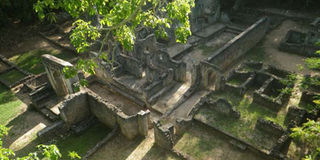Gede Ruins: Ancient city that lures tourists, researchers alike

Gede Ruins. The ancient ruins are located on the outskirts of Malindi town on the edges of the famed Arabuko Sokoke Forest along Mombasa-Malindi highway. PHOTO | FILE | NATION MEDIA GROUP
What you need to know:
Famous site attracts thousands of tourists, students researchers annually.
- The Museum’s gallery hosts samples of archaeological discoveries and a set of traditional Swahili artifacts.
The ultimate moment to a visitor however beckons as one encounters the mystic ruins of the ancient city just behind the museum building to the south through a narrow nature trail.
Gede Ruins is a must-visit place for any visitor to Malindi in Kilifi County. It is an incredible site located on the outskirts of Malindi town on the edges of the famed Arabuko Sokoke Forest along Mombasa-Malindi highway.
Gede National Monument exudes both peculiar and spell-binding legendary tales about a mysterious ancient Swahili city that is believed to have been home to about 2000 people, described as sea bound traders and committed Muslims who lived in the period between the 14th and 16th centuries.
The archaeological site attracts thousands of tourists, including history students, researchers and nature lovers all-year round.
The site’s awesome sceneries that depict an abandoned ancient settlement, leaves many a visitor enchanted with its calmness and magnificent structures.
A gate in the shape of an African hut and built with coral reefs welcomes a visitor to the Gede Museum whose building is surrounded by tall palm trees and neat pavements to depict an antique Arabic palace.
The Museum’s gallery hosts samples of archaeological discoveries and a set of traditional Swahili artifacts and models representing the diverse cultures of Kenya’s coastal Mijikenda people.
The ultimate moment to a visitor however beckons as one encounters the mystic ruins of the ancient city just behind the museum building to the south through a narrow nature trail.
GRIPPING TALES
As a tour guides start narrating the gripping tales of the ancient city built using coral reef, concentration is lost as the structures scream for attention.
The ruins’ labyrynth of endless dungeons and lanes that depict a kings’ palace, mosques, swimming pools, tombs and well marked streets, takes over the imaginations of a visitor.
A tree house hangs from a slanting huge Baobab tree believed to be over a hundred years old. It overlooks a dated tomb with Arabic inscriptions.
It is believed that the inhabitants of the city sailed across the world trading in many regions of Africa, Asia and Europe.
The site attracted archeological activities between 1948 and 1958 long after it was declared a national monument under an Act of Parliament of the former colonial government of Kenya.
Venetian beads, Chinese vases and an Indian lamp were among the archaeological excavation items that were discovered at the site to draw conclusions about the lives and sea tours of the ruined city’s inhabitants.
Hostility of conquering traditional hostile tribes like the Oromo, who moved into the region during the same period from Somalia, is believed to have scared away the city’s dwellers in the late 16th century.
In fact the word Gede or Gedi is an Oromo word that means ‘precious’.
Traditional Giriama dancers armed with drums and other traditional attires, keep vigil outside traditional hut models adjacent the ruins and museum ready to entertain visitors.
Curio sellers salivate for a kill as young Gleonon monkeys play by, soliciting for goodies from visitors.
From here one can choose to visit the adjacent Kipepeo Butterfly Farm and Snake Park all within the precincts of Gede Ruins.
Memories of ghostly Gede Ruins will always haunt a visitor, long after the visit.




